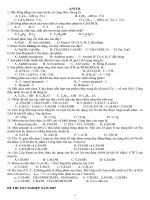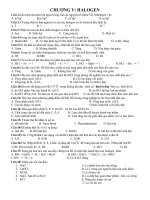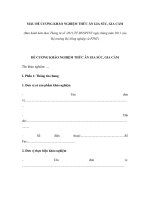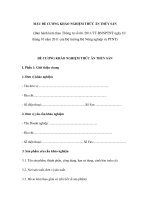Đề cương trắc nghiệm Hành Vi Tổ Chức (Organizational Behavior) CHƯƠNG 6
Bạn đang xem bản rút gọn của tài liệu. Xem và tải ngay bản đầy đủ của tài liệu tại đây (47.51 KB, 15 trang )
Chapter 6: Perception and Personality in
Organizations
6-1. Which of the following is an example of perceptual
organization and interpretation?
a. You recognize that a problem exists with the production
process because the warning light flashes.
b. You conclude that the older man wearing the suit is the
store manager.
c. The employment interviewer notices from the resume that an
applicant was raised in the same town as the interviewer.
d. All of the above
e. None of the above
The question was not answered. The correct answer
is "b". (Coaching responses are only available for answered
questions)
6-2. Which of these refers to the process of receiving
information about and making sense of the world around us?
a. Personality
b. Projection
c. Attitude
d. Perception
e. Self-serving bias
The question was not answered. The correct answer
is "d". (Coaching responses are only available for answered
questions)
6-3. The process of filtering information received by our senses
refers to
a. Social identity
b. projection.
c. Selective attention
d. stereotyping
e. Recency effect
The question was not answered. The correct answer
is "c". (Coaching responses are only available for answered
questions)
6-4. Which of the following causes us to screen out large blocks
of threatening information?
a. Perceptual defence
b. Perceptual grouping
c. Mental models
d. Attribution theory
e. Johari Window
The question was not answered. The correct answer
is "a". (Coaching responses are only available for answered
questions)
6-5. A police detective has few clues about a homicide. Until
more clues are found, s/he continues to scan for clues and avoids
focusing on the available clues. This is an example of:
a. Perceptual defence.
b. Social identity
c. Self-serving bias
d. Splatter vision
e. Self-fulfilling prophecy
The question was not answered. The correct answer
is "d". (Coaching responses are only available for answered
questions)
6-6. The broad world views or "theories-in-use" that we rely on
to guide our perceptions and behaviours are known as:
a. Personality conflicts.
b. Self-fulfilling prophecies.
c. Attribution errors
d. Stereotypes
e. Mental models
The question was not answered. The correct answer
is "e". (Coaching responses are only available for answered
questions)
6-7. Stereotyping is an extension of
a. perceptual defence
b. attribution theory
c. social identity theory
d. Johari Window
e. projection
The question was not answered. The correct answer
is "c". (Coaching responses are only available for answered
questions)
6-8. Which process involves deciding whether an observed
behaviour or event is largely caused by internal or external
factors?
a. Personality
b. Attribution
c. Selective attention
d. Social identity
e. Self-fulfilling prophecy
The question was not answered. The correct answer
is "b". (Coaching responses are only available for answered
questions)
6-9. According to social identity theory
a. we tend to believe our own actions are caused by motivation
or ability rather than the situation.
b. A person's perceptions strongly influence how another person
with act.
c. one characteristic of a person shapes our general impression
of that person which, in turn, biases our perceptions about the
other characteristics of that person.
d. we have a strong need to quickly make sense of other people.
e. We perceive ourselves as members of several groups.
The question was not answered. The correct answer
is "e". (Coaching responses are only available for answered
questions)
6-10. The question "How often does the person act this way in
other settings?" addresses which of these in the attribution
theory?
a. Consensus
b. External attribution
c. Consistency
d. Distinctiveness
e. Internal attribution
The question was not answered. The correct answer
is "d". (Coaching responses are only available for answered
questions)
6-11. Fundamental attribution error occurs when:
a. we evaluate specific features of the target person based on a
general impression of that person
b. We increase our open area by reducing our blind area.
c. We tend to attribute the behaviour of other people to
internal factors more than external factors.
d. Employees behave in a way consistent with our previous
expectations of them.
e. None of the above occur.
The question was not answered. The correct answer
is "c". (Coaching responses are only available for answered
questions)
6-12. Diversity management programs:
a. are mainly intended to correct deep-rooted prejudice or
intolerance in the workplace
b. gives employees more accurate information about people
from different backgrounds
c. communicate the value of diversity in the workplace
d. Do all of he above.
e. Do only 'b' and 'c'
The question was not answered. The correct answer
is "e". (Coaching responses are only available for answered
questions)
6-13. All of these are part of the "Big Five" personality
dimensions except
a. locus of control.
b. agreeableness.
c. openness to experience.
d. emotional stability.
e. extroversion.
The question was not answered. The correct answer
is "a". (Coaching responses are only available for answered
questions)
6-14. The Myers-Briggs Type Indicators measures:
a. The amount of stress employees experienced during the
previous week.
b. Sensing, judging, and other personality traits identified by
Carl Jung.
c. The amount of open area identified in the Johari Window.
d. The extent to which the individual has an internal or external
locus of control.
e. The employee's tendency to rely on stereotypes rather than
factual information.
The question was not answered. The correct answer
is "b". (Coaching responses are only available for answered
questions)
6-15. Myers-Briggs Type Indicator (MBTI) includes all of these
dimensions except
a. Sensing and intuition
b. Judging and perceiving
c. Thinking and feeling
d. Extroversion and introversion
e. Conscientiousness and irresponsibility
The question was not answered. The correct answer
is "e". (Coaching responses are only available for answered
questions)
TRUE or FALSE
6-1. One influence on selective attention is the size, intensity,
motion, repetition, and novelty of the target (including people).
True / False
The question was not answered. The correct answer
is "True". (Coaching responses are only available for answered
questions)
6-2. The perceptual process begins by creating a self-fulfilling
prophecy.
True / False
The question was not answered. The correct answer
is "False". (Coaching responses are only available for answered
questions)
6-3. "Splatter vision" helps us to form a clear understanding
about a single cause of behaviour and to screen out most
information unrelated to that explanation.
True / False
The question was not answered. The correct answer
is "False". (Coaching responses are only available for answered
questions)
6-4. Personal identity refers to our self-perception as members in
various social groups.
True / False
The question was not answered. The correct answer
is "False". (Coaching responses are only available for answered
questions)
6-5. Mental models shape how we perceive the world around us.
True / False
The question was not answered. The correct answer
is "True". (Coaching responses are only available for answered
questions)
6-6. According to social identity theory, we define ourselves in
terms of our differences with people who belong to other social
categories.
True / False
The question was not answered. The correct answer
is "True". (Coaching responses are only available for answered
questions)
6-7. Attribution theory mainly explains how we interpret the
causes of behaviour.
True / False
The question was not answered. The correct answer
is "True". (Coaching responses are only available for answered
questions)
6-8. In organizational settings, employees are more likely to be
benefactors of positive self-fulfilling prophecy than victims of
negative self-fulfilling prophecy.
True / False
The question was not answered. The correct answer
is "False". (Coaching responses are only available for answered
questions)
6-9. Projection bias is usually a defence mechanism to protect
our self-esteem.
True / False
The question was not answered. The correct answer
is "True". (Coaching responses are only available for answered
questions)
6-10. Diversity management sessions are intended to correct
deep-rooted prejudice or intolerance.
True / False
The question was not answered. The correct answer
is "False". (Coaching responses are only available for answered
questions)
6-11. An individual's personality is relatively stable.
True / False
The question was not answered. The correct answer
is "True". (Coaching responses are only available for answered
questions)
6-12. The main objective of the Johari Window process is to
increase the size of the unknown area.
True / False
The question was not answered. The correct answer
is "False". (Coaching responses are only available for answered
questions)
6-13. Extroversion refers to people who are careful, dependable,
and self-disciplined.
True / False
The question was not answered. The correct answer
is "False". (Coaching responses are only available for answered
questions)
6-14. People with internal locus of control are well suited to
leadership positions and other jobs requiring initiative,
independent action, complex thinking, and high motivation.
True / False
The question was not answered. The correct answer
is "True". (Coaching responses are only available for answered
questions)









